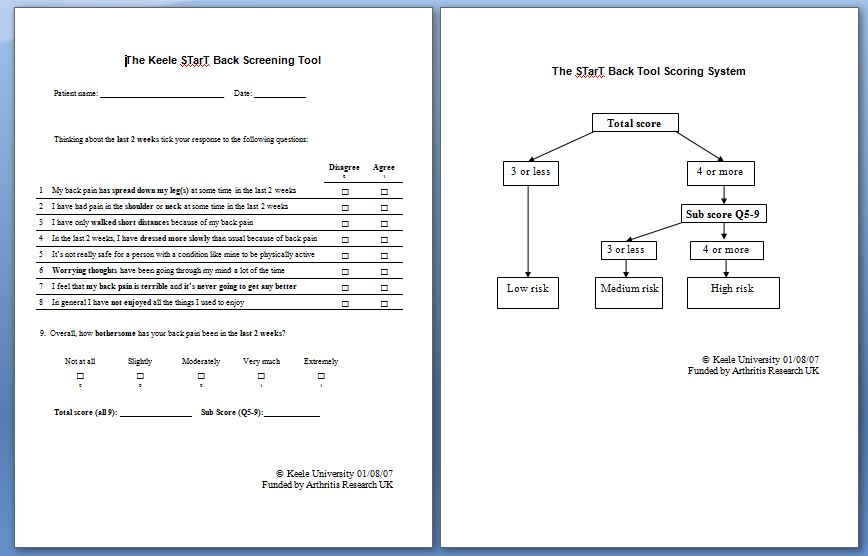Images (9-item tool)
Objective (9-item tool)
The Keele STarT Back Screening Tool (SBST) (9-item version) is a brief validated tool, designed to screen primary care patients with low back pain for prognostic indicators that are relevant to initial decision making [1].
Intended Population (9-item tool)
Primary care patients with low back pain [1].
Method of Use (9-item tool)
The STarT Back Screening Tool helps primary care clinicians (GPs, physiotherapists etc) to group patients into three categories of risk of poor outcome (persistent disabling symptoms) – low, medium, and high-risk. By being able to categorise patients into these 3 groups, clinicians are then able to target interventions to each sub-group of patients to help outcome [1].
The STarT Back Screening Tool is available in a number of languages including: English, Dutch, French, Spanish, Danish and Welsh (Keele University n.d). The tool produces two scores: overall scores and distress subscale scores [2].
- The distress subscale score is used to identify the high-risk subgroup. To score this subscale add the last 5 items; fear, anxiety, catastrophising, depression and bothersomeness (bothersomeness responses are positive for ‘very much’ or ‘extremely’ bothersome back pain). Subscale scores range from 0 to 5 with patients scoring 4 or 5 being classified into the high-risk subgroup [1].
- The overall score is used to separate the low risk patients from the medium-risk subgroups. Scores range from 0-9 and are produced by adding all positive items; patients who achieve a score of 0-3 are classified into the low-risk subgroup and those with scores of 4-9 into the medium-risk subgroup [1].
Evidence (9-item tool)
The STarT Back trial [3] compared the clinical and cost effectiveness of stratified management approach; allocating patients to different treatment pathways based on their prognosis (low, medium, or high risk of poor outcome); with that of current best practice. The trial demonstrated that this new model results in greater health benefits, achieved at a lower average health-care cost, with an average saving to health services of £34.39 per patient and societal savings of £675 per patient [1].
The Keele SBST 6-Item Version
The Keele SBST 6-item version includes 6 of the same items as the original 9-item version, with 3 items excluded (fear, anxiety and pain elsewhere), making it quicker it use. However, [1] have reported that their research (unpublished) shows that the 6-item version is only able to allocate patients to one of two subgroups (low risk or high risk). Patients who score 3 or more items positively have a high-risk of persistent disabling low back pain.
The Keele SBST 9-Item Clinical Measurement Tool
The Keele SBST 9-item clinical measurement version has been designed to help physiotherapists objectively measure the severity of the domains screened by the original 9-item version. When repeated measures are used this enables an objective marker of change over time to be made for individual items; essentially this version can be used as an outcome measure in addition to being used to subgroup patients in the same way as the original 9-item version. In order to be able to use this version to subgroup patients in the same way as the original 9-item version, cut-offs have been established for each item. The cut-off points that equate to an agree/positive score on this version for subgrouping are:
- Leg pain – ‘moderately’ or more
- Shoulder/neck – slightly or more
- Dressing – 5 or more
- Walking – 5 or more
- Fear – 7 or more
- Worry – 3 or more
- Catastrophising – 6 or more
- Mood – 7 or more
- Bothersomeness – ‘very’ or more [1]
The authors[1] suggest it is very easy to produce an acetate using these cut-off that you place over the questionnaire to quickly enable you to score the clinical measurement tool for subgrouping purposes.
The Keele SBST 5-Item Generic Condition Tool
The Keele SBST 5-item generic condition version is the 9-item psychosocial subscale adapted to screen/identify distress in other conditions. Scores range from 0-5 with patients scoring 4 or 5 being classified as a high psychosocial risk [1].
[1] have stated that for now they are unable to recommend the use of a modified version of the SBST (including the 5-item generic condition version) for conditions other than low back pain.
Links
Keele STarT Back Screening Tool website: References
- ↑ 1.001.011.021.031.041.051.061.071.081.091.10 Keele University. STarT Back Screening Tool Website. ↑ Hill JC, Dunn KM, Lewis M, Mullis R, Main CJ, Foster NE, Hay EM. A primary care back pain screening tool: identifying patient subgroups for initial treatment. Arthritis Care & Research 2008;59:632-41. fckLRhttp://onlinelibrary.wiley.com/doi/10.1002/art.23563/full (accessed 29 July 2013).
- ↑ Hill JC, Whitehurst DG, Lewis M, Bryan S, Dunn KM, Foster NE, Konstantinou K, Main CJ, Mason E, Somerville S, Sowden G, Vohora K, Hay EM. Comparison of stratified primary care management for low back pain with current best bractice (STarT Back): a randomised controlled trial. Lancet 2011;378:1560-71. fckLRhttp://www.ncbi.nlm.nih.gov/pubmed/21963002 (accessed 29 July 2013).

